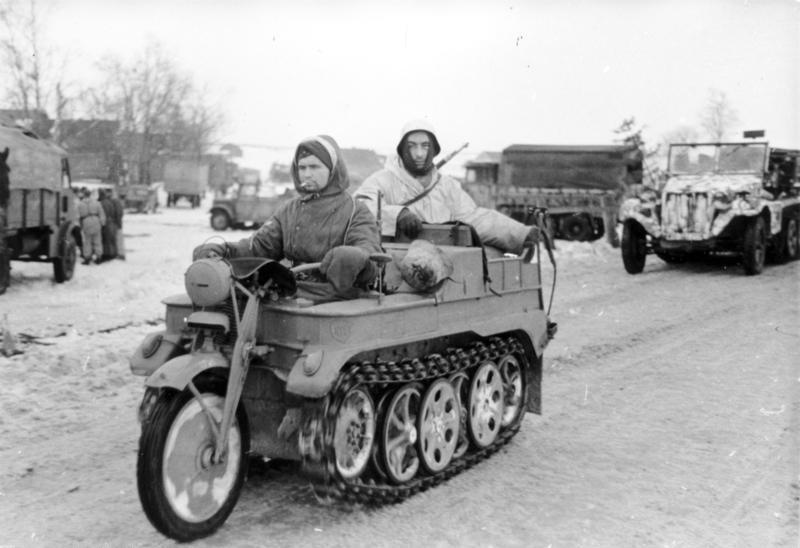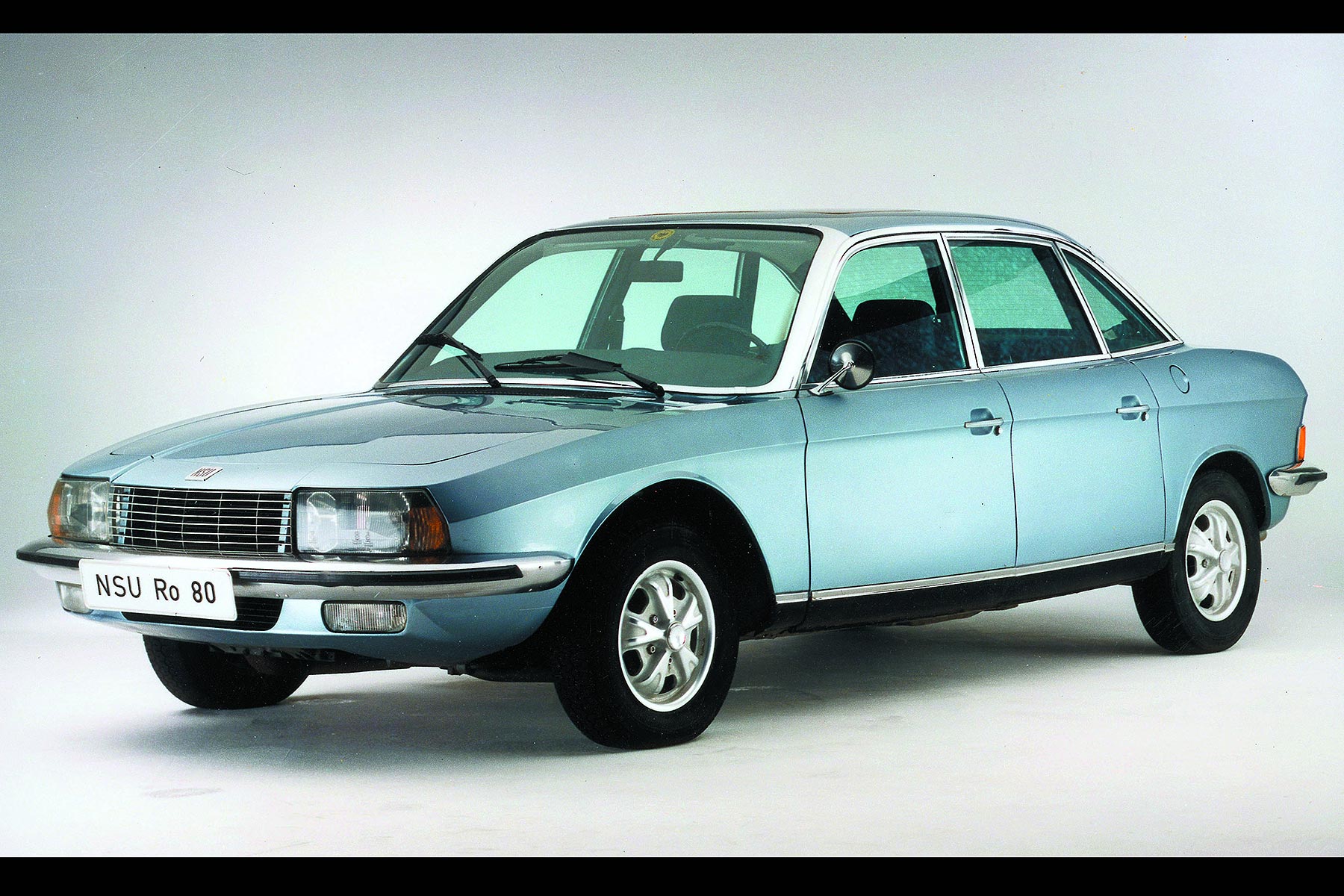NSU, an abbreviation of the town of
Neckarsulm near Stuttgart, originally started its life in 1873 as a producer of
knitting machines. After rapid growth they started making bicycles and by 1892
bicycles took over all the production. The first NSU motorcycle appeared in
1901 and the first car in 1905.
They never managed to break through with
their car production so that by 1932 under pressure from the banks the car
factory at Heilbronn was sold to Fiat for assembly of Fiat cars in Germany. The
company continued to make an increasing range of motorcycles, some innovative
including supercharged race models up to the Second World War. During the war
they made a half track motorcycle that saw service mainly on the Russian front;
this was continued in civilian form after the war:

It was after the war that the company
regrouped and the totally bombed out factory started production of the pre war
models, but in ‘49 the new designs starting with the Fox appeared These were
revolutionary, using a pressed steel monocoque frame. In ‘53 the Max appeared
with a 250cc four stroke engine that had the overhead cams driven by con rods
and by ‘55 NSU was the biggest motorcycle manufacturer in the world. Many will
remember the original moped, the Quickly, that sold Europe-wide in huge numbers.
At the time of the Max coming on stream NSU
were breaking world speed records for motorcycles at the Bonneville salt flats
and in ‘56 an NSU became the first motorcycle to top 200mph. In the same period
they entered Grand Prix racing with a very advanced 125 and 250cc twin cylinder
Rennmax machines that were at the time in a class of their own. This is the ‘53
250cc Rennmax - the later racers had full “dustbin” fairings:
In ‘54 NSU stopped factory racing but had
developed a race version of the single cylinder Max known as the Sportmax that
in a private rider's hands became the only production racer to win a world
championship. Only 32 were ever made and went to selected riders with a spare
engine. They became the mainstay of the 250 class for many years, and alongside
many road going Max’s were converted to racers with Sportmax parts; these too
had many successes in club and international racing.
Sadly by ‘63 motorcycle production finished
for NSU as the drive towards car production was seen as the way forward for the
company, plus by then the ominous presence of the Japanese companies was
beginning to be felt.
To complete this short section on NSU's
racing pedigree, one of the selected riders to become a Sportmax owner was John
Surtees. He won numerous races on his and set many class lap records. His lap
record for the old Crystal Palace circuit stood for over twenty years, something
unbelievable in today's racing: he also won the 1955 Ulster Grand Prix on his
version.
In 1957 Surtees' father, a friend of Mike
Haiwood's father, was pressured to sell the bike for Mike to ride.He took it to
SA for a winter's racing and won every race he entered, setting many lap records. In ‘58 aged 18 he won 25 races with the Sportmax and his first world
championship points and his first TT podium.
Here it is in all its glory with the Hailwood
team colours:
So in ‘68 NSU ended its association with
making motorcycles. In ‘57 NSU had re entered the car market with the Prinz, a
small car with a doubled up version of the Max engine. This as a small runaround
was fairly successful and was produced until ‘68 but in the meantime NSU was
preparing for something totally different, a car with a rotary engine designed
by Felix Wankel.
In ‘64 NSU offered the public the world's
first rotary engined car, the Spyder:

A version of the Prinz followed, one having
a twin rotor engine. At the time many believed this was the dawning of a new
age in automobile propulsion but under the surface problems were already
beginning to emerge: unreliability in the rotary engines was mainly caused by
unsuitable materials to seal the rotor tips and rapid wear was causing failures
and the warranty bill was rising.
It was in ‘67 with the unveiling of the
company's first hopefully mass production car with a rotary engine that the
clouds of failure started to gather. The NSU Ro80 was a very modern design with
independent suspension and disc brakes and the twin rotor engine giving 115bhp
and for then a very modern design one that has stood the test of time.
Virtually every car manufacturer in the
world had taken out licenses for the rotary engine, though only Citroen who had
share of the hopeful engine plant built a rotary car. The model was aborted. NSU
had had great hope that royalties would pay for their investment in ever
increasingly costly development, but it was not to be: there were several
prototypes built by other companies including a Corvette by General Motors with
quad rotors, but nothing went into production.
Despite winning the car of the year award
in ‘67 and several design awards, the car had slow sales:

- and the increasing heavy costs of engine
replacements even at low mileages was sinking the company. In ‘69 the company
was taken over by VW who used the factory for Audi production though the Ro80
staggered on until the last NSU was produced in ‘77. The name was never used by
Audi after that time.
The only other company to produce a rotary
engined car was Mazda, in fact under license they pre-dated the Ro 80 as a mass
production car with the Cosmo, a sports car that stayed in production for twenty
years:

Mazda have persevered and improved the
rotary unit over many years, even largely overcoming the main problem rotor tip
sealing using ceramics. In 1991 Mazda won Le Mans, the only Japanese
manufacturer to win Le Mans; they had overcome reliability problems with
earlier race efforts:
Le Mans promptly banned the rotary engine
from competing again, though the ban has since been lifted, to late to save a
unique exhaust note.
Mazda have of course until recently
persevered with the rotary and the last model the RX – 8 had overcome most of
the reliability issues and this lovely car deserves a successor, but the fuel
economy was still poor compared to peer cars and the emissions , that are now
such an issue were also sub standard,
Mazda stated that they would come back with a rotary engined car in
2019, but that is with the charge towards electric and hybrid vehicles now in
doubt.
So now all that effort to produce a better
fuel driven power unit for automobiles has come to naught, save a very
prestigious Le Man win which Felix Wankel would have been ecstatic to see as
proof his design worked; for NSU it was a very costly venture.
Footnote
Some years back I saw a Rs80 on the road
when I lived in Essex,:very modern and distinctive in style, many of the cars
having used up their engines were converted to Ford V4s the engine being short
enough to fit in the smaller rotary engined bay, it was probably one of those.


3 comments:
Back in the 70s I ran a Mazda RX3 for a while. It was total fun, looked like a plain ordinary saloon car and left almost everything behind when you accelerated. Mind you it really was a plain ordinary saloon car in every other respect, brakes were dreadful and the old fashioned steering box techology was decidedly dodgy at speed.
In the early seventies I had if I remember rightly an NSU 1200. A decent car and easy to work on but with the rear engine it was skittish on the motorway especially when windy. Needed plenty of weight in the front boot.
Another fascinating one from you, Wiggia. Not the same thing but we used to drive a Goliath.
Post a Comment